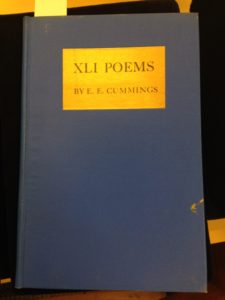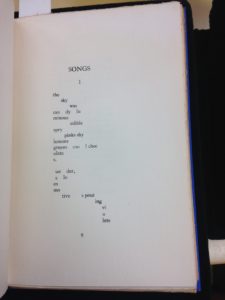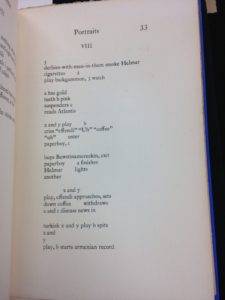XLI Poems (E.E. Cummings, 1925)
 This is a book of poems by E. E. Cummings, published in 1925, just after the heyday of artistic cubism. Upon first glance, the reader can see that Cummings experimented with different ways of laying out his poems on the page. One of the important aspects of cubist art was appealing to different senses, such as the use of textured elements to appeal to the sense of touch through sight. Similarly, cubist literature, such as these poems, use the spacing on the page to influence the sense of sound–the spacing between words affects how one hears the poem in one’s head. Cummings was by no means the only writer to utilize these techniques during the cubist era–both Apollinaire and Gertrude Stein were well known for creating visual poetry, often in even more outrageous ways than included in this compilation.
This is a book of poems by E. E. Cummings, published in 1925, just after the heyday of artistic cubism. Upon first glance, the reader can see that Cummings experimented with different ways of laying out his poems on the page. One of the important aspects of cubist art was appealing to different senses, such as the use of textured elements to appeal to the sense of touch through sight. Similarly, cubist literature, such as these poems, use the spacing on the page to influence the sense of sound–the spacing between words affects how one hears the poem in one’s head. Cummings was by no means the only writer to utilize these techniques during the cubist era–both Apollinaire and Gertrude Stein were well known for creating visual poetry, often in even more outrageous ways than included in this compilation.

There are several examples of creatively spaced poetry in this book, including Songs I and XI and Portraits VIII, which are all pictured below. However, possibly the most intriguing use of space is in Sonnet VII. Sonnet VII is a Petrarchan (or Italian) Sonnet, following the structure of an octet (abbaabba) followed by a sestet (cddeec) and written in iambic pentameter. Sonnets are one of the most rigid forms of poetry, and are usually identifiable first by their shape. However, Sonnet VII does not look like a “regular” sonnet: it has breaks mid-octet, mid-sestet, and even mid-line. For readers who are familiar with the rhythm of reading a sonnet, it almost feels awkward to read the poem with the added spacing. Since this poem is already a very sensory poem, appealing to both smell and sight, this additional play on the sound of the poem provides the perfect example of how cubism influenced the senses of literature.


